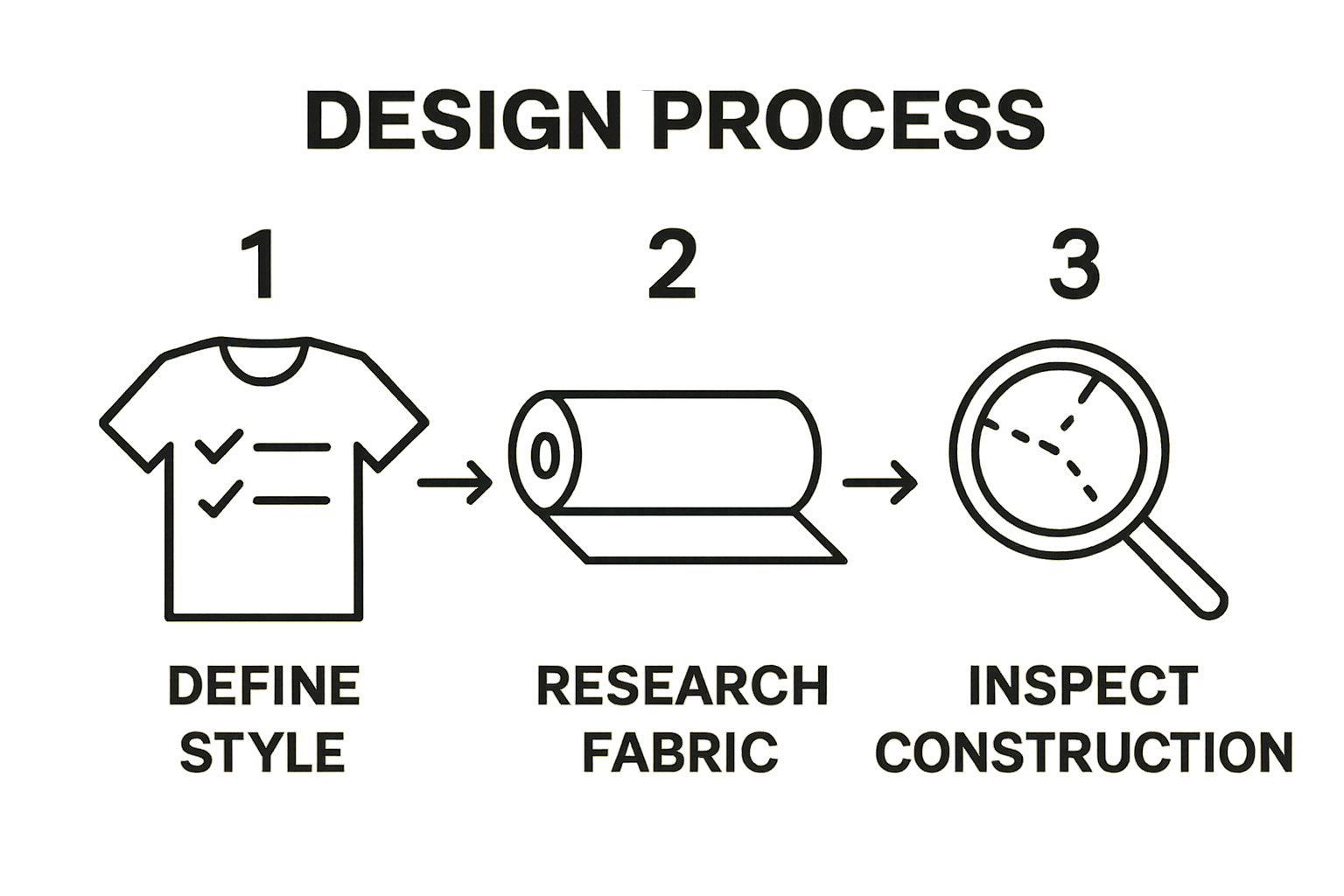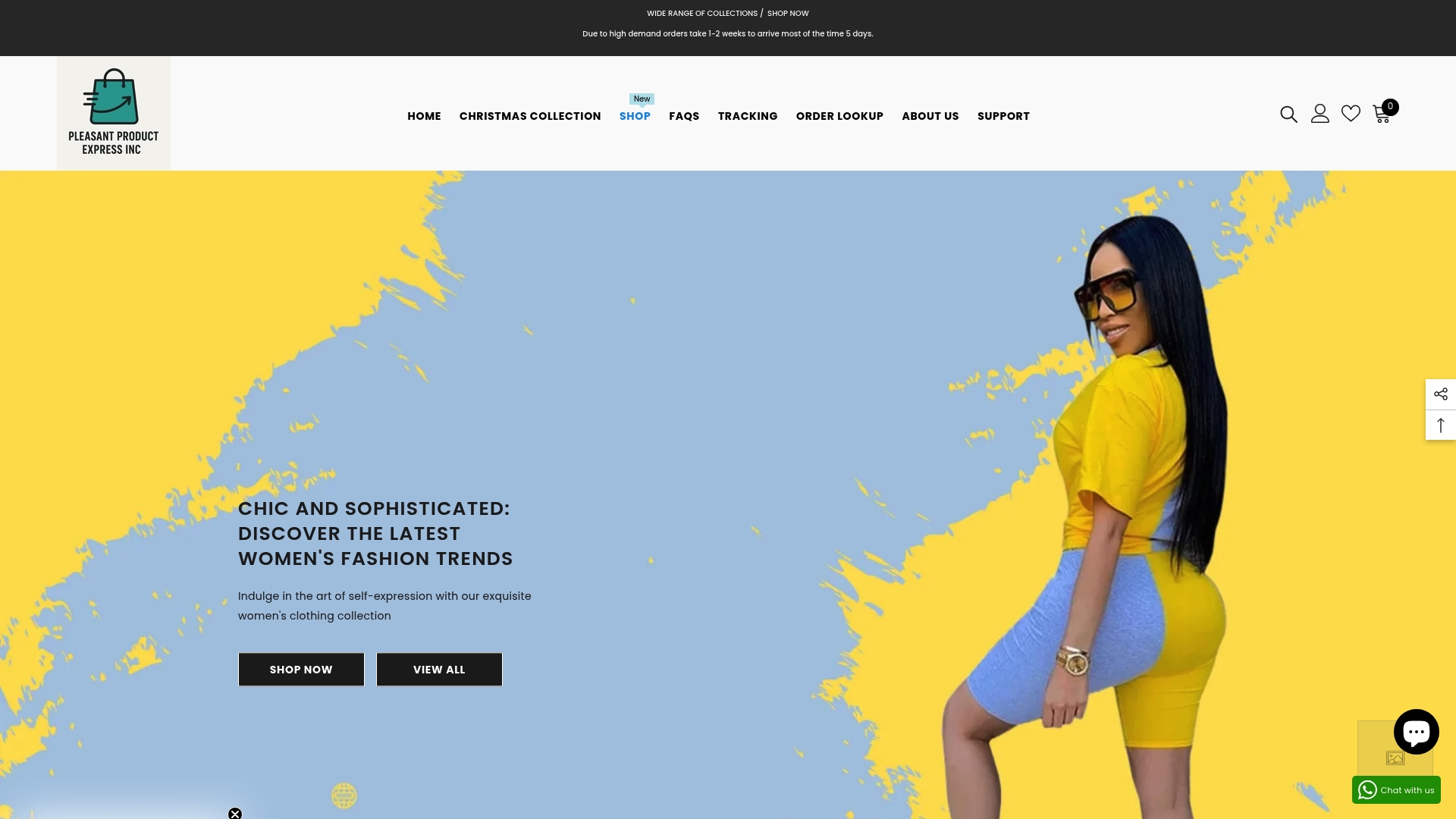How to Choose Quality Clothing: A Step-by-Step Guide
Building a wardrobe that truly suits you is about so much more than chasing trends. Most people wear just 20 percent of their clothes 80 percent of the time. That sounds backwards, right? The real secret is that quality clothing has less to do with price tags and designer labels, and everything to do with understanding your own style, the fabric in your hands, and what actually lasts beyond a couple of washes.
Table of Contents
- Step 1: Define Your Personal Style And Needs
- Step 2: Research Fabric Types And Their Qualities
- Step 3: Inspect Garments For Construction And Fit
- Step 4: Prioritize Ethical And Sustainable Brands
- Step 5: Test Garments Through Wear And Care
Quick Summary
| Key Point | Explanation |
|---|---|
| 1. Define your personal style | Understand your unique style by analyzing your wardrobe, lifestyle, and what makes you confident. |
| 2. Research fabric types | Learn about fabric characteristics to select clothes that offer comfort, durability, and style suited to your needs. |
| 3. Inspect garments thoroughly | Check for quality stitching, fit, and construction to ensure long-lasting clothing that maintains its appearance. |
| 4. Prioritize ethical brands | Choose sustainable brands based on transparency, worker welfare, and environmental impact to support responsible consumerism. |
| 5. Test garments through wear | Assess clothing quality by wearing and caring for garments, observing how they perform over time. |
Step 1: Define your personal style and needs
Choosing quality clothing begins with understanding your unique personal style and specific wardrobe requirements. This foundational step is crucial in building a clothing collection that not only looks great but also serves your practical needs.
Personal style is more than just following current fashion trends. It’s about discovering a look that makes you feel confident, comfortable, and authentically yourself. Start by examining your lifestyle, professional environment, and personal preferences. Consider the activities you regularly engage in: Are you a professional who needs crisp, tailored pieces? A creative professional requiring more flexible, expressive clothing? Or someone who values comfort and functionality in their daily wear?
To truly define your style, spend time observing what you already wear and feel most confident in. Look through your existing wardrobe and identify patterns. What colors consistently appear? Which cuts and silhouettes make you feel most comfortable? These observations provide valuable insights into your inherent style preferences.
Creating a style mood board can be an excellent visual tool in this process. Use platforms like Pinterest to collect images of outfits, color palettes, and clothing styles that resonate with you. This visual exploration helps crystallize your aesthetic preferences and provides a clear reference point when shopping for new clothing.
Realistic style assessment also means acknowledging your body type and what clothing styles complement your natural shape. Not every trendy item will suit your physique, and that’s perfectly okay. Focus on finding pieces that highlight your best features and make you feel great.
For additional inspiration on developing a unique fashion perspective, read our guide on mixing fashion styles which offers creative insights into personal style development.
Beyond aesthetics, consider your practical needs. Make a list of clothing essentials required for your daily life. This might include:
- Professional work attire
- Casual weekend clothing
- Exercise and athletic wear
- Special occasion outfits
- Seasonal clothing adaptations
By thoroughly understanding your personal style and lifestyle requirements, you’ll be well-prepared to make informed, quality clothing choices that truly reflect who you are.
Step 2: Research fabric types and their qualities
Understanding fabric types is fundamental to selecting quality clothing that meets your comfort, durability, and style requirements. Different fabrics offer unique properties that can significantly impact how a garment looks, feels, and performs in various settings.
Natural fibers form the foundation of high-quality clothing. Cotton, for instance, remains a versatile favorite due to its breathability and soft texture. Wool provides exceptional temperature regulation, keeping you warm in cold environments while wicking moisture away from your skin. Silk represents luxury, offering a smooth, lightweight feel perfect for more refined clothing pieces.
Synthetic fabrics have revolutionized clothing technology. Polyester provides remarkable wrinkle resistance and durability, making it ideal for travel and active wear. Nylon offers incredible strength and quick-drying capabilities, which explains its popularity in sportswear and outdoor clothing. According to research from textile experts, understanding these fabric characteristics helps consumers make more informed clothing selections.
Blended fabrics represent an innovative approach to clothing design. Cotton-polyester blends combine the breathability of cotton with polyester’s durability, creating garments that are comfortable and long-lasting. Wool-synthetic blends offer enhanced performance by maintaining natural fiber benefits while improving wear resistance.
When researching fabric qualities, pay attention to specific characteristics beyond basic material composition. Weight, weave, and finish dramatically influence a fabric’s performance and appearance. Lightweight fabrics work well for layering and warm climates, while heavier weaves provide warmth and structure.
Learn more about choosing comfortable clothing that matches your lifestyle and personal preferences. Consider creating a quick reference guide of fabric types that suits your specific needs:
- Cotton: Breathable, soft, ideal for everyday wear
- Wool: Temperature regulating, moisture-wicking
- Silk: Lightweight, luxurious, best for special occasions
- Polyester: Durable, wrinkle-resistant, quick-drying
- Blended fabrics: Combines best properties of multiple fibers
Successful fabric research means understanding how different materials perform in various environments and align with your personal style and practical requirements.
To help you quickly compare different fabric types for quality clothing, here is a table summarizing fabric characteristics and best uses based strictly on the article content.
| Fabric Type | Key Qualities | Best For |
|---|---|---|
| Cotton | Breathable, soft | Everyday wear |
| Wool | Temperature regulating, moisture-wicking | Cold weather, layering |
| Silk | Lightweight, luxurious | Special occasions |
| Polyester | Durable, wrinkle-resistant, quick-drying | Travel, active wear |
| Nylon | Strong, quick-drying | Sportswear, outdoor clothing |
| Cotton-Poly Blend | Breathable, durable | Versatile, long-lasting wear |
| Wool-Synthetic Blend | Enhanced performance, durable | Performance outerwear |
Step 3: Inspect garments for construction and fit
Choosing quality clothing goes far beyond selecting attractive fabric and style. Careful inspection of garment construction and fit is critical to ensuring you invest in pieces that will look great and last longer. This step requires a detailed eye and hands-on examination of potential clothing purchases.
Begin by performing a thorough visual inspection of the garment’s overall structure. High-quality clothing demonstrates precise, consistent stitching with no loose threads, uneven seams, or visible imperfections. Look closely at areas of high stress like shoulder seams, underarms, and waistbands. These regions reveal the true craftsmanship and potential durability of the clothing item.
Seam quality represents a fundamental indicator of clothing construction. Robust seams should lay flat, have tight and even stitching, and show no signs of potential unraveling. Run your fingers along seams to feel their strength and consistency. Double-stitched or reinforced seams typically indicate superior manufacturing and longer-lasting clothing.
Buttons, zippers, and closures are additional critical inspection points. Check that buttons are securely attached and aligned properly. Zippers should glide smoothly without catching fabric or feeling flimsy. Metal zippers generally indicate higher quality compared to plastic alternatives. For button-down shirts, ensure buttons are evenly spaced and stitched with a thread that matches the garment’s color.
Fit assessment requires more than just trying on a garment. Movement is key. When attempting on clothing, perform simple actions like raising your arms, sitting, and walking to understand how the piece moves with your body. Clothing should provide comfortable range of motion without excessive pulling or bunching.
Learn strategies for perfectly matching outfits that complement your body’s natural lines and enhance your overall appearance. Pay attention to how clothing drapes and follows your body’s contours.
Consider these essential fit verification points:
- Shoulders should align perfectly with your natural shoulder line
- Sleeve length should end at your wrist bone
- Trouser and skirt waistbands should sit comfortably without digging
- Chest and hip areas should have slight ease for comfortable movement
Remember that size labels vary between brands. Always prioritize how a garment feels and looks on your body over the number printed inside. By thoroughly inspecting construction and fit, you transform clothing shopping from a passive experience into a strategic, informed decision-making process.
Use this checklist table to verify key quality indicators when inspecting garment construction and fit, helping ensure your clothing selections meet high standards for comfort and durability.
| Verification Point | What to Check For | Why It Matters |
|---|---|---|
| Stitching | Precise, even, tight, no loose threads | Indicates durability and craftsmanship |
| Seams | Lay flat, reinforced, consistent | Prevents unraveling, improves longevity |
| Buttons & Zippers | Secure, aligned, smooth function, quality material | Functional durability, ease of use |
| Shoulder Alignment | Lines up with your natural shoulder line | Proper fit, professional appearance |
| Sleeve/Waistband Position | Ends at wrist bone/sits comfortably at waist | Comfort and appearance |
| Range of Motion | Clothing moves comfortably with your body | Everyday comfort and wearability |
| Ease/Allowances | Slight room at chest and hip | Prevents restriction, ensures good fit |

Step 4: Prioritize ethical and sustainable brands
Choosing quality clothing now extends beyond personal style and fit. Ethical and sustainable fashion represents a powerful way to make responsible consumer choices that positively impact global manufacturing practices and environmental sustainability.
Understanding the deeper implications of your clothing purchases means looking beyond the price tag. Sustainable brands prioritize fair labor practices, environmentally friendly manufacturing processes, and transparent supply chains. These companies invest in worker welfare, reduce environmental waste, and create clothing that tells a story of social responsibility.
Research becomes your most valuable tool in identifying truly ethical brands. Look for certifications like Fair Trade, GOTS (Global Organic Textile Standard), and B Corp, which validate a company’s commitment to ethical practices. These credentials indicate rigorous standards in worker treatment, environmental stewardship, and sustainable production methods.
Consumer awareness has transformed the fashion industry. Modern clothing brands increasingly recognize that customers want transparency about their manufacturing processes. Seek out companies that openly share information about their production methods, material sourcing, and environmental impact. Many brands now provide detailed storytelling about their supply chain, allowing consumers to make informed decisions.
Evaluating a brand’s sustainability involves multiple considerations. Examine their material sourcing practices, commitment to reducing carbon footprint, and approach to waste management. Some brands use recycled materials, implement water-conservation techniques, or create clothing designed for long-term durability.
Learn more about affordable fashion choices that align with your ethical standards and budget constraints. Sustainable clothing doesn’t always mean expensive clothing.
Consider these key indicators of an ethical clothing brand:
- Transparent supply chain information
- Fair wages and safe working conditions
- Use of sustainable or recycled materials
- Minimal environmental impact
- Long-lasting, high-quality product design
Making ethical fashion choices requires patience and consistent research. Start by gradually replacing existing wardrobe items with sustainable alternatives. Each purchase is an opportunity to support responsible manufacturing and reduce global environmental impact. By prioritizing ethical brands, you’re not just buying clothing. You’re investing in a more sustainable, equitable global fashion ecosystem.
Step 5: Test garments through wear and care
The ultimate test of clothing quality occurs not in the store, but through real-world wear and systematic care. Your clothing’s true performance emerges through repeated use and maintenance, revealing its durability, comfort, and long-term value.
Initial wear provides critical insights into a garment’s real-world performance. When you first wear a new piece, pay attention to how it feels during different activities. Comfort, mobility, and fabric response under movement are key indicators of quality. Notice how the clothing behaves during walking, sitting, or more dynamic movements. Fabric that maintains its shape, doesn’t bunch uncomfortably, and feels pleasant against your skin signals superior construction.
Washing and care practices dramatically impact clothing longevity. According to cleaning experts, proper maintenance can significantly extend a garment’s useful life. Always review care labels meticulously, as each fabric requires specific treatment. Delicate items might need hand washing or gentle cycle, while robust materials tolerate more rigorous cleaning methods.
Temperature, detergent selection, and drying techniques play crucial roles in fabric preservation. Cold water generally helps maintain color and prevent shrinkage, while certain fabrics require specific detergents to maintain their integrity. Avoid harsh chemicals that can break down fabric fibers or cause color fading.
Repeat wearing provides the most comprehensive quality assessment. Observe how the garment responds after multiple washes and wears. High-quality clothing maintains its shape, color, and structural integrity even after numerous cleaning cycles. Watch for signs of wear like thread loosening, color fading, or fabric thinning. These indicators help you understand the true value of your clothing investment.
Discover affordable fashion strategies that help you maximize your clothing’s lifespan and maintain its original quality. Smart care extends beyond washing techniques.
Consider these essential wear and care verification points:
- No significant color fading after multiple washes
- Maintained original shape and fit
- Consistent fabric texture and strength
- No unexpected shrinkage or stretching
- Seams and stitching remain intact
Remember that quality clothing is an investment. Treating each piece with careful attention transforms your wardrobe from a collection of disposable items into a curated selection of lasting, performance-driven garments. By systematically testing and maintaining your clothing, you develop a keen understanding of true textile quality.
This checklist table makes it easy to remember what to look for when testing the lasting quality of garments during real-world use and care.
| Wear & Care Checkpoint | What to Observe | Indicates Quality |
|---|---|---|
| Color Retention | No significant color fading after washes | Fabric durability |
| Shape & Fit | Maintains original shape and fit | Construction strength |
| Fabric Texture | Stays consistent, no pilling or thinning | Material quality |
| Shrinkage & Stretching | No unexpected changes after washing | Proper fabric prep |
| Seam & Stitch Integrity | Seams and stitches remain intact | Long-term wear |

Upgrade Your Wardrobe with Lasting Quality from Pleasant Product Express
Struggling to find clothing that matches your style, fits perfectly, and stands the test of time? After following our step-by-step guide on how to choose quality clothing, you understand that true value comes from breathable fabrics, ethical sourcing, and flawless construction. Yet, finding one store that delivers all these essentials along with affordability can feel overwhelming.

Why settle for less? Make every clothing choice smart and satisfying. At Pleasant Product Express INC, you discover thoughtfully selected men’s, women’s, and baby fashion designed for real people and real lives. Enjoy comfort you can feel, fabrics tested for wear and care, and a shopping experience centered on trust. Visit our site now, see how easy quality can be, and take the first step to a wardrobe you love. Your best buy is only a click away at Pleasant Product Express INC.
Frequently Asked Questions
How do I define my personal style before buying new clothes?
To define your personal style, assess your lifestyle and preferences. Look through your current wardrobe to identify colors, cuts, and silhouettes that you feel confident in. Creating a mood board with outfits or styles you admire can also help clarify your aesthetic.
What should I consider when researching fabric types for clothing?
When researching fabric types, consider properties like breathability, durability, and texture. Natural fibers such as cotton and wool offer comfort, while synthetic fabrics like polyester and nylon provide durability and moisture resistance. Understanding these characteristics will help you choose clothing that suits your needs.
How can I ensure garments fit well when shopping?
To ensure a good fit, try on garments and perform simple movements like sitting and walking. Check that the garment aligns with your body’s natural lines and offers comfortable range of motion. Focus on key areas such as shoulder alignment, sleeve length, and waistband fit to assess overall comfort.
Why is it important to choose ethical and sustainable clothing brands?
Choosing ethical and sustainable clothing brands supports fair labor practices, reduces environmental impact, and promotes transparency in manufacturing. Investing in sustainable fashion contributes to a more equitable and responsible global fashion industry, while also encouraging better practices among manufacturers.
Recommended
- How to Choose Comfortable Clothing for Every Occasion – Pleasant Product Express Inc
- Master the Outfit Matching Process for Effortless Style – Pleasant Product Express Inc
- The Ultimate Guide to Affordable Fashion for 2025 – Pleasant Product Express Inc
- Ultimate Guide to Mixing Fashion Styles for Unique Looks – Pleasant Product Express Inc







